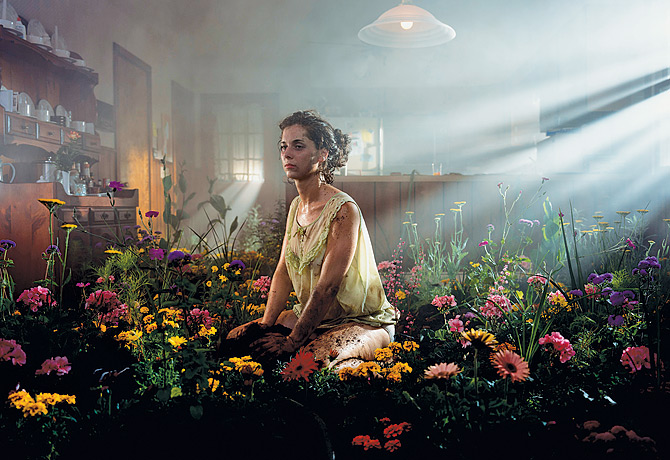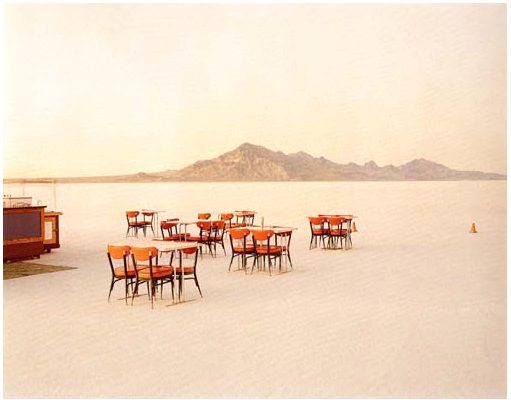I really appreciated the exposition on photography at the NGV. I spent hours commenting and observing the pictures closely and I liked it. In my opinion the NGV collected those pieces of work because the art photographers who were chosen for this exposition were either the first ones to experiment with the chemical composition of paper for photographs and create new ways of photography (i.e. Edward Steichen) or they were the first ones to make a change in a photography movement (i.e. Paul Strand).
The first thing I was really impressed by was the stereoscopic daguerreotype in the little glass box. I've never seen one before. Having read the history of photography, it was interesting to see it in real life.
However, I would also like to discuss some photographs from the exposition.
(All the facts and information concerning the Photographs is based on the information provided from the NGV.)
William Henry Fox Talbot
1843, "Portrait of a man" (no titel)

Source: http://www.ngv.vic.gov.au/climages/large/Fe1/Fe100158.jpg
This is a salted paper photograph, which is very sensitive to light. I was really surprised how accurate and sharp it was, if you consider that it was one of the first photographs ever .You can even see the facial features of this man's face on the original.
Sometimes I just ask myself why these pictures look so beautiful. Do they show creative potential because the photographer was skilled enough to generate the Aura of this special moment (as Walter Benjamin would call it) or do the pictures just look wonderful because the picture itself, or the paper which it was printed on, are from another time period and doesn't look like perfect digital pictures we are used to see every day??? We are curious about the old clothes of the people, the locations that don't exist anymore and even the people's faces don't look like modern faces we are used to see every day.
Difficult to find the answer, however, I suppose we appreciate the old photographs so much just because they are kind of antique. Over time the consistency and quality of the paper change, so that the photographs appear a little out of focus which makes them look similar to paintings.
For example the photograph of Nadar, "Alexandre Dumas" (1855)

Source: http://amica.davidrumsey.com/luna/servlet/view/search?q=AMICOID=CMA_.1983.198%20LIMIT:AMICO~1~1&sort=INITIALSORT_CRN%2COCS%2CAMICOID&search=Search
Dumas is not looking directly in the camera, but with a slight smile on his face.
This photograph is really interesting. The sharpness of his hands and face on the one hand and the blurring around his arms and shoulders on the other hand, remind the viewer of a painting. However, it is a photograph with all the accurate details of Dumas' face , hair and hands.
Or for example the Photograph of Thomas Annan, "Close no. 11 Bridgegate (1897)

Source: http://www.ngv.vic.gov.au/climages/large/Fe1/Fe100246.jpg
Although it shows a great depth of space through dark colours in the front and bright colours in the background, it really gives the impression of a painting.
It seems that this could be one of the reasons that we consider these photographs as art: the similarity to paintings!
However, it is also important to mention that Annan did great work in finding this place and chose just the right moment to capture all the beauty and the seemingly romantic atmosphere of this narrow lane.
The first thing I was really impressed by was the stereoscopic daguerreotype in the little glass box. I've never seen one before. Having read the history of photography, it was interesting to see it in real life.
However, I would also like to discuss some photographs from the exposition.
(All the facts and information concerning the Photographs is based on the information provided from the NGV.)
William Henry Fox Talbot
1843, "Portrait of a man" (no titel)

Source: http://www.ngv.vic.gov.au/climages/large/Fe1/Fe100158.jpg
This is a salted paper photograph, which is very sensitive to light. I was really surprised how accurate and sharp it was, if you consider that it was one of the first photographs ever .You can even see the facial features of this man's face on the original.
Sometimes I just ask myself why these pictures look so beautiful. Do they show creative potential because the photographer was skilled enough to generate the Aura of this special moment (as Walter Benjamin would call it) or do the pictures just look wonderful because the picture itself, or the paper which it was printed on, are from another time period and doesn't look like perfect digital pictures we are used to see every day??? We are curious about the old clothes of the people, the locations that don't exist anymore and even the people's faces don't look like modern faces we are used to see every day.
Difficult to find the answer, however, I suppose we appreciate the old photographs so much just because they are kind of antique. Over time the consistency and quality of the paper change, so that the photographs appear a little out of focus which makes them look similar to paintings.
For example the photograph of Nadar, "Alexandre Dumas" (1855)

Source: http://amica.davidrumsey.com/luna/servlet/view/search?q=AMICOID=CMA_.1983.198%20LIMIT:AMICO~1~1&sort=INITIALSORT_CRN%2COCS%2CAMICOID&search=Search
Dumas is not looking directly in the camera, but with a slight smile on his face.
This photograph is really interesting. The sharpness of his hands and face on the one hand and the blurring around his arms and shoulders on the other hand, remind the viewer of a painting. However, it is a photograph with all the accurate details of Dumas' face , hair and hands.
Or for example the Photograph of Thomas Annan, "Close no. 11 Bridgegate (1897)

Source: http://www.ngv.vic.gov.au/climages/large/Fe1/Fe100246.jpg
Although it shows a great depth of space through dark colours in the front and bright colours in the background, it really gives the impression of a painting.
It seems that this could be one of the reasons that we consider these photographs as art: the similarity to paintings!
However, it is also important to mention that Annan did great work in finding this place and chose just the right moment to capture all the beauty and the seemingly romantic atmosphere of this narrow lane.














































